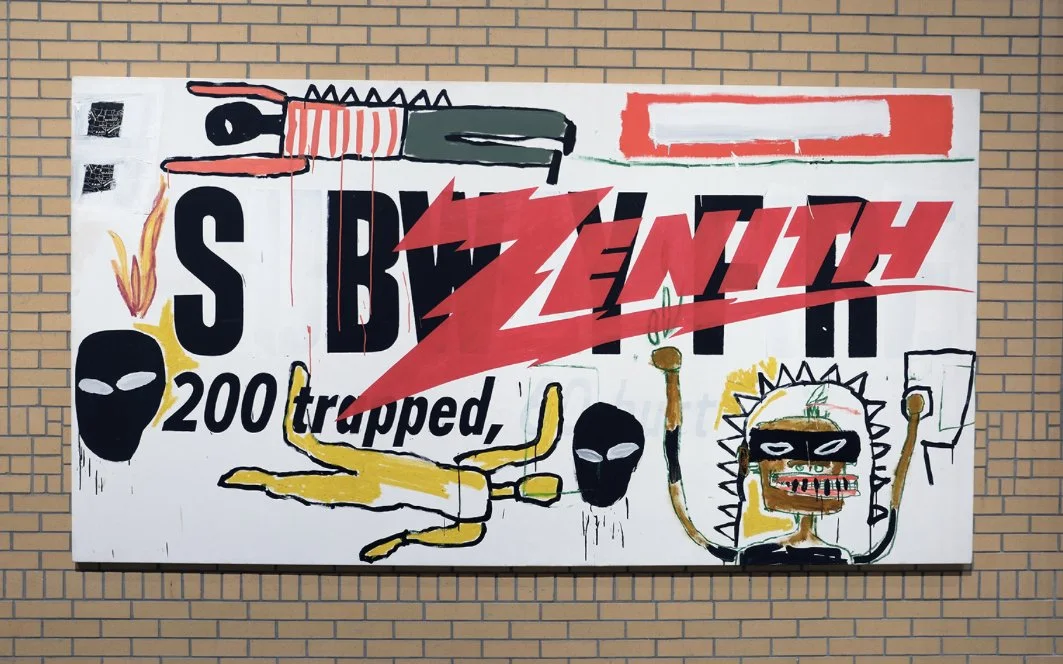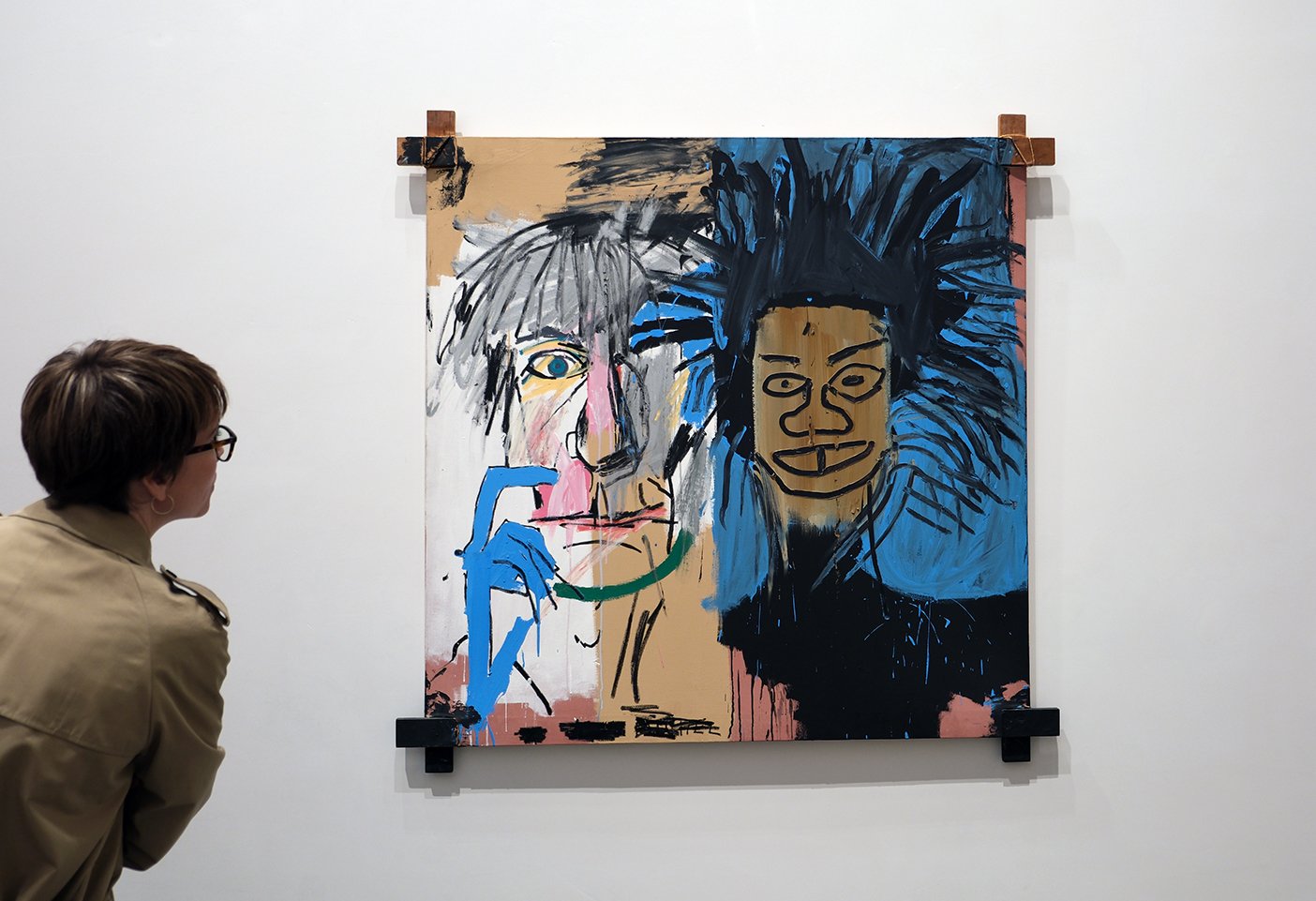Warhol and Basquiat: Exploring an Unprecedented Artistic Collaboration
Collaboration No. 19, Zenith subway fire. Photo by Jamie Lubetkin.
They could hardly be more different, these two 20th century art visionaries. One cool and dispassionate, one hot and emotional; a pop art pioneer and a neo-expressionist virtuoso; one 56 and an established art world icon, one 24 and in the throes of a meteoric rise. As different as black and white, Andy Warhol and Jean-Michel Basquiat participated in an historically unprecedented collaboration that produced over 160 works during a brief, but extraordinarily productive mid-1980s collusion.
Now, almost 40 years after they were created, more than 30 of the works return to New York Nov. 1 as part of Basquiat x Warhol at the Brant Foundation in the East Village, not far from the studio on Great Jones Street that Warhol owned and where Basquiat lived, worked and died. The works meld Warhol’s calculated and precise pop-culture iconography with Basquiat’s visceral frenetic style to address contemporary topics such as racism, gay rights, consumerism and the AIDS epidemic.
The show is curated by art historian and Basquiat scholar Dieter Buchhart and Peter M. Brant, who owns the gallery and is a globally important collector of both artists. The Brant foundation mined Brant’s collection for separate solo shows of work by Basquiat in 2019 and Warhol earlier this year. Anna Karina Hofbauer, who co-wrote Basquiat: By Himself and participated in other projects with Buchhart is listed as a collaborator in the curation.
Curator Dieter Buchhart passes in front of the work Cops. Photo by Jamie Lubetkin.
During a press preview on Oct. 26., Buchhart said many of the works in the show have not been seen publicly in decades and some have not been seen in New York since the collaboration took place in 1984-85
“Bringing these works home to the city where they were painted, where they were created, where they were discussed, where this dialectic space was created, it’s breathtaking actually,” he said.
Virtually without precedent, the collaboration between Warhol and Basquiat has attracted new attention recently with the current show, a much larger version Basquiat x Warhol presented this spring at Fondation Louis Vuitton in Paris and a Broadway production about the two called The Collaboration.
The collaborative works have fetched far less at auction in recent years than the works of either artist individually. Last year, GE/Skull sold for $4.6 million and ½ Keep Frozen, which is part of the current show, went for $3 million, both at Christie’s. By comparison Warhol’s 1964 piece Shot Sage Blue Marilyn (1964) fetched more than $195 million at Christie’s last year. Basquiat’s 1982 monumental Untitled black skull piece sold for over $110 million at Sotheby’s in 2017.
Buchhart said he has been surprised by the low prices fetched by the collaborative works, given their unprecedented nature and their place in art history. It is possible that there are some lingering questions about the value of the work because of the poor critical reception it received when it debuted in 1985 at Tony Shafrazi’s New York gallery.
Dos Cabezas, the portrait of Warhol and Basquiat that Basquiat painted in just a few hours after the two met. Photo by Jamie Lubetkin.
“It was a moment when anything Warhol did was highly criticized, it was actually a bad coincidence in that sense. There were also some critical swipes at Basquiat at that time….Not all critics were that negative, but it was not positive at all,” Buchhart said.
Artistic friends are hardly rare: Renoir and Monet, Manet and Degas (reunited right now in a fabulous show at The Met), Van Gogh and Gauguin, Jackson Pollock and Willem de Kooning, to name a few.
Warhol and Basquiat were acquainted, but their friendship blossomed after a 1982 lunch arranged by Swiss gallerist and collector Bruno Bischofberger. As Warhol recounted in his diary: “Down to meet Bruno Bischofberger (cab $7.50). He brought Jean Michel Basquiat with him.…he was just one of those kids who drove me crazy…And so had lunch for them and then I took a Polaroid and he went home and within two hours a painting was back, still wet, of him and me together,” Warhol wrote.
That painting, a 60-by-60 inch acrylic and oil stick on canvas with wood supports called Dos Cabezas done in Basquiat's signature neo-expressionist style, is a critical element of the current show. While not a collaborative work, the ease and speed with which Basquiat dispatched Dos Cabezas impressed Warhol considerably and likely contributed to the shy and reserved Warhol’s openness to a deeper relationship with his young admirer.
Olympic Rings. Photo by Jamie Lubetkin.
The two developed an unusual friendship and began working together on the pieces, first at Warhol’s factory on Broadway and later at his last Factory location on Madison Avenue near 33rd St. Basquiat explained the collaboration’s dynamics in his mid-80s interview with writers Becky Johnston and Tamra Davis.
“He would start most of the paintings,” Basquiat told Johnston and Davis. “He would put something very concrete or recognizable, like a newspaper headline or a product logo, and then I would sort of deface it, and then I would try to get him to work some more on it, and then I would work more on it. I would try to get him to do at least two things, you know? [laughing] He likes to do just one hit and then have me do all the work after that,” he said.
Olympic Rings, at approximately 15 feet by 7 feet one of the largest pieces in the show, is typical of the works presented by Brant. Inspired by the 1984 Los Angeles Summer Olympic Games, the piece started with a series of five hand-painted sets of the iconic Olympic rings in various sizes and combinations of red, green, yellow, blue, black and white. The rings are typical of Warhol’s dispassionate hand painted iconography, while Basquiat’s emotionally charged response is typical of his contributions to the works. On top of Warhol’s rings, Basquiat added a stern black face, emitting droplets of black sweat. The face casts a dark shadow into the heart of several of the rings, perhaps suggesting the significance of African-American athletes to America’s Olympic teams.
Three of the bags from the piece Ten Punching Bags (Last Supper). Photo by Jamie Lubetkin.
Another example is Cops, one of several that began with Warhol’s mechanical rendering of the Arm & Hammer logo, along with a headline Cops Fight Gay Hiring. Basquiat then camouflaged many of the letters, to make the headline into a puzzle that can be solved only on very close examination of the work. Basquiat engaged in similar semantic gamesmanship on other pieces in the show. To this fractured headline, Basquiat superimposed a self-portrait wearing his iconic crown and a green serpent slithering across the works lower half. Both the snake and the cartoonish black face appear angry in their occupation of the work’s foreground.
The collaboration was not limited to painting, as evidenced by Ten Punching Bags (The Last Supper), a monumental sculpture consisting of 10 boxing heavy bags suspended from the gallery’s 30-foot ceiling. The punching bags began with Warhol renderings of Jesus from his Last Supper series, which explored the artist’s struggles with Catholic guilt. Basquiat defaced them all with the word Judge along with other words and symbols including the Basquiat crown, a spider, a black figure in a body bag and numerous Xs.
As far as actual artistic collaborations go, there are really no historic precedents. Christo Javacheff and Jeanne-Claude Denat de Guillebon created some of the largest and best-known works of public art over a decades-long collaboration. There was Picasso’s 1949 collaboration with photographer Gjon Mili, that yielded some 30 images of Picasso drawing with light. It’s probably not ridiculous to include Robert Rauschenberg’s erasure of a de Kooning sketch as an example, since de Kooning was in on the plan to create Erased de Kooning Drawing in 1953.
Then there are the drawings yielded via the invention of Exquisite Corpse in 1925, in which surrealists André Breton, Yves Tanguy, Jacques Prévert, and Marcel Duchamp contributed to works without first seeing earlier contributions from others. Frida Kahlo, Man Ray, Joan Miró and many other greats of the era participated in the experiment.
Basquiat x Warhol runs through January 7, 2004, at the Brant Foundation, 421 E 6th Street.
Originally published by Whitehot Magazine.





